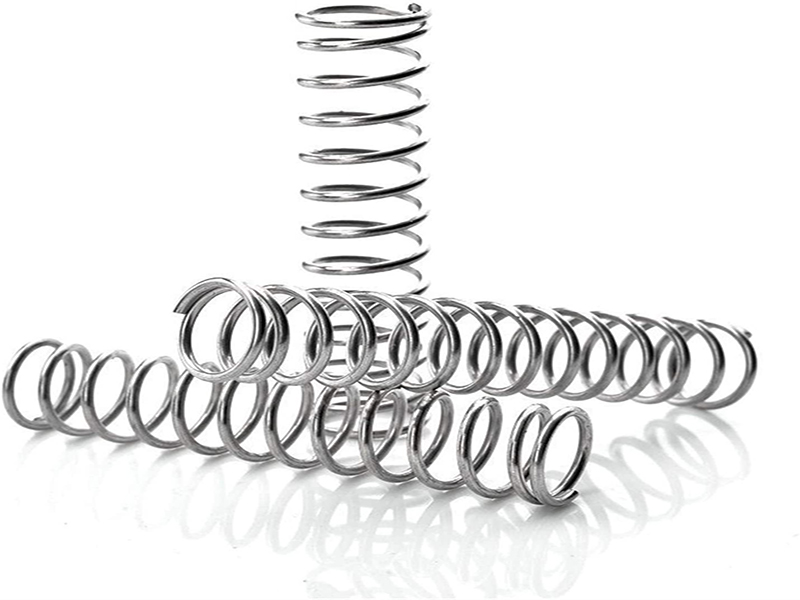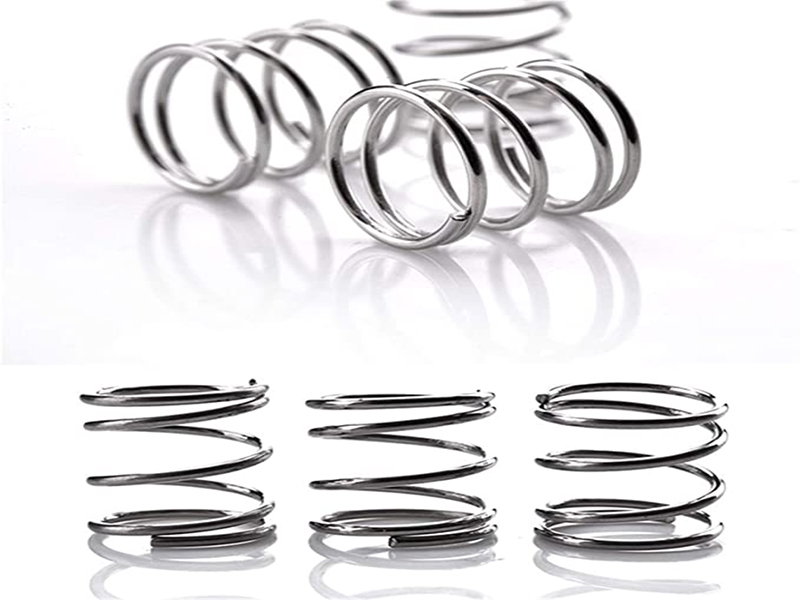

Depending on the size of the spring steels, the forming and heat treatment methods vary.
The diameter is thinner or the thickness of the spring steels should generally be cold drawn spring steels wire or cold rolled spring steels strip made. Steel wire available 60, 70, 65Mn, T7A, T8A and T9A and other steel. According to GB/T4357-1989, carbon spring steel wire is divided into three groups B, C, D. Group B tensile strength in 1080 ~ 2800 MPa, for general low stress spring steel and other uses; Group C tensile strength in 1270 ~ 3140 MPa, for medium stress spring steel; Group D tensile strength in 1520 ~ 3240 MPa, for high stress spring steel. In the same group, the smaller the diameter of the wire, the higher the strength.
Cold-formed spring steel wire can be divided into three categories according to different manufacturing processes.
The main feature of this production process is that the steel wire undergoes a certain process of rapid isothermal cooling during the cold drawing process and is then cold drawn to the required size. In T8A steel, for example, the first normalised steel wire pickling, after three cold drawing, so that the total drawing volume of 50%, and then the steel wire to 3.5m/min speed through the heating furnace, heated to 890 ~ 920 ℃ austenitising temperature, in the 500 ~ 550 ℃ lead bath isothermal decomposition into soxhletic tissue, and then by repeated drawing to the required diameter. This type of steel wire is mainly 60, 70, 65Mn grades, the highest strength up to 3000 MPa or more, and a high plasticity. Cold rolled spring steel with this type of steel wire, just 200 to 300 ℃ to remove stress tempering, to eliminate stress and make spring steel shaped. Motorbike shock absorbing spring steel φ6.0 × φ35 × 280, the material is lead bath quenched and tempered 55SiCrA steel wire winding, after forming by 250 ℃ × 2h low-temperature annealing, the use of strength to about 1680 MPa, the hardness of about 46-48 HRC.
This type of steel wire is cold drawn to the specified size and then oil quenched and tempered. The tensile strength of the wire is not as good as the lead bath isothermal treatment of cold-drawn steel wire, but its performance is more uniform and consistent, the fluctuation range of strength is small, widely used in the manufacture of various power machinery valve spring steel. This type of steel wire cold rolled into a spring steel, but also only need to be stress relieved tempering, without quenching and tempering treatment.
Such as vehicles on the plunger spring steel, into the oil needle valve spring steel, etc., material 65Mn steel. Oil quenched and tempered steel wire, diameter 0.8 ~ 1.5mm, in the cold circle are cold hardening, with high strength, must be stress relieved tempering, 200 ~ 250 ℃ × 1h. And for 70 steel torsion spring and tension spring, the need to then roll the end of the processing, so there is a second tempering. The first 200 to 250 ℃ × 1h; the second tempering temperature of 180 to 200 ℃ × 1h air cooling.
The stress relieving tempering temperature should be appropriate. Temperature is too low, can not fully eliminate stress; temperature is too high, due to tempering softening effect, so that the tensile strength and elastic limit is reduced. Table 1 for several steel wire cold rolled spring steel after the stress relief tempering temperature range, the time is generally 30 to 60min, too long can not make performance improvements.
Spring steel made of this steel wire are required to quench and temper treatment to achieve the required mechanical properties. This type of steel wire has 50CrVA steel wire, 60Si2Mn steel wire and 55SiMnB steel wire.

Spring steels wire diameter or spring steel plate thickness greater than 10 to 15mm spiral spring steels or plate spring steels, generally in the heating quenching when forming. Spring steels manufacturing process is roughly as follows (to plate spring for example): flat steel cut off → heated to quenching temperature after bending special fixture clamping direct quenching + medium temperature tempering → shot blasting → assembly. The quenching temperature at this point is 50 to 80°C higher than usual, the use of residual heat immediately after forming quenching, but also in the salt bath furnace heating, cooling in oil to 100 to 150°C can be removed for medium-temperature tempering. Tempering temperature is selected according to the performance requirements of the spring steels, generally within the range of 450-500°C. The hardness after tempering is approximately 38 to 52 HRC. Plate spring tempered hardness of 39 to 47 HRC, spiral spring steel tempered to 44 to 50 HRC, tempered by shear stress spring steel 47 to 52 HRC.
A steel company continuous casting machine sliding water spout spring steel, the highest use temperature of 500 ℃. Cylindrical spiral spring steel wire diameter φ12.6mm, inner diameter φ116mm, high temperature hardness of 45-55HRC, material 30W4Cr2VA, with a cylindrical hollow mandrel (material: Q235) set of spring steel for heating fixed, using equipment B84T real air quenching furnace, first with 850 ℃ × 120min convection preheating, improve the uniformity of low-temperature heating, shorten the heating time, reduce the heating time. Reduce the temperature difference between the workpiece to reduce quenching deformation; then 1050-1070 ℃ × 70min vacuum heating, heating rate are used 10 ℃ / min, pressurized gas quenching, gas quenching pressure of 5 × 105pa, the spring steel cold to about 80 ℃ out of the furnace, such as a large amount of furnace loading, can be appropriate to increase the quenching pressure. Must be tempered in time, tempering is also carried out in this vacuum furnace, using 600 ℃ carbon phenomenon appears, the detection of hardness 48-51HRC.

Because small surface defects (such as decarburisation, cracks, inclusions, burrs and scars, etc.) can cause stress concentrations that reduce the fatigue strength of spring steel. In order to improve the fatigue strength of spring steels, after quenching and tempering spring steels can be shot peened to eliminate surface defects and stresses generated by surface hardening. Tests have shown that the use of shot peening 60Si2Mn steel spring steel life increased by 5 to 6 times.
Spring steel can be isothermal quenching, mainly used in heat treatment machine deformation is small as well as the desire to obtain good plasticity and toughness of the occasion. When the hardness is the same, isothermal quenching + tempering has a higher plasticity and toughness, but the elastic limit is correspondingly lower.
In recent years, spring steels steel heat treatment application isothermal quenching, deformation heat treatment and a series of new processes to further improve its performance, has achieved certain results, worthy of strong advocacy. In addition, spring steel may produce a trace of plastic deformation under long-term stress, thereby reducing the elasticity and precision, which is not allowed for the high requirements of spring steel. To solve this problem need to spring steel “strong pressure treatment”, that is, the spring steels to pressure, so that the circles are in contact with each other to maintain 24h, this process allows the spring steel plastic deformation in advance, thus avoiding the plastic deformation in service and affect the elasticity and dimensional accuracy
① cold compression treatment, that is, at room temperature, the strong pressure treatment for several hours to dozens of hours; ② hot compression treatment, the strong pressure device into the temperature of a certain constant temperature furnace, maintain the appropriate time, remove the unloading and fast cooling to room temperature; ③ magnetic pressure treatment, that is, the strong pressure spring steels device into the surrounding magnetic field in the bath furnace treatment; ④ electric pressure treatment, that is, the strong pressure spring steels device into the two poles between the plate heated by electricity for a relatively After a short period of time, remove the fast cooling. Strong pressure treatment of spring steels does not appear to relax the first stage of the larger relaxation rate, only the second stage of the smaller relaxation rate, which effectively improves the stress relaxation resistance of spring steels, so that the spring steel work 10 years of load loss rate of less than 5% or so.

For Further Details,Please Feel Free To Contact Us: